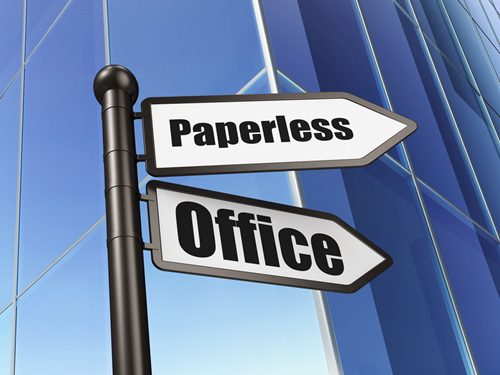
Wadih Pazos
Wadih founded both PairSoft and PaperSave. He is an avid technologist who specializes in streamlining operations and maximizing productivity.
View all posts by Wadih PazosWadih Pazos

According to GreenBiz, the concept of a paperless office first appeared in a 1975 Businessweek article that said that offices would trade paper for digital work by the mid-1990s. Clearly, that did not happen, but the concept is still around and with today’s modern technology we can come closer and closer to making it a reality.
The first step in getting your office paperless, according to another article from GreenBiz, is investing in an enterprise content management system. These systems allow companies to easily make the jump from paper to digital, as the source reported they allow for the capture, archiving, and searching of paper documents in digital forms so whatever any employee needs is at his fingertips at a moment’s notice.
ECM systems also create automated processes in the office that reduce the amount of paper, energy, and resources needed to complete a task. When an employee doesn’t have to manually look up a document or fax or ship a document to another location, the company will save both time and paper. ECM systems can even help save on transportation costs and cut down on greenhouse emissions, as digital storage and sharing of documents means fewer cars and trucks transporting documents from place to place, according to GreenBiz.
Enterprise content management means moving your business to the cloud, which can have other advantages. Centralization online can give your company access to free email accounts, word processing, and other services, saving more money, according to BusinessGreen.
For businesses that deal with a high volume of reports on a daily, weekly or monthly basis, e-reader technology can provide immense savings, BusinessGreen reported. Getting an e-reader for each employee who deals with reports allows for rapid and targeted distribution of any report the company generates, which will help further the financial and environmental benefits of going paperless. Distributing necessary reports directly to a hand-held device saves on printing and paper costs. It also saves time, especially if employees are mobile and shipping the reports adds an extra layer of complexity to the process.
Working from home has become a much more common and accepted business practice.
In the modern business landscape, telecommuting, or working from home, has become a much more common and accepted business practice. This can mean a substantial reduction in paper, as most of the work done by an individual employee can be done online. Messages and documents sent between workers can now be downloaded to devices from the cloud instead of physically being printed and moved from place to place.
Shifting to a telecommuting model can benefit your employees in more ways than one. A Global Workplace Analytics study said that two-thirds of employees would take advantage of the opportunity to work from home if it was offered, with 36 percent saying they would forego a pay raise in order to be able to telecommute.
Replacing traditional printed reports with mobile technology, like tablets, can cut down on errors at the same time it saves paper. In hospitals, replacing the traditional clipboard at the foot of the bed with tablets has led to fewer errors due to misread hand-written instructions, according to BusinessGreen. It also keeps pages of what formerly would have been wasted paper in a single digital place.
The benefits of going to a paperless model are readily apparent, but in the past have been something of a pipe-dream without the needed technology. Now in the modern world, technology has caught up and the dream of the paperless office is becoming a reality.
Automated workflows empower your team to focus on larger, more complex initiatives without having to think about small processes.


Many organizations start with manual receipt handling, fragmented card feeds and slow AP processes. Implement AI agents to auto-capture receipts, route approvals, enable punch-out buys and post to the ERP.
Result: faster batching, fewer errors and cost savings. “This saves us hours every month.”
Many organizations face slow, paper-heavy AP and fragmented procurement that waste time and inflate costs. AI Agents can automate approvals, PO matching and record sync to improve speed, accuracy and control. Client quote: “It freed up hours and made our process reliable.”
Operational drag and rising costs slow growth: teams waste time on manual tasks, misaligned priorities and opaque processes. AI Agents help automate routine work and coordinate actions across teams. “We’ve lost time to repeats and handoffs,” says a typical client.
Companies struggle with manual procurement, fragmented approvals, and costly integrations that slow growth and obscure spend. Our AI Agents streamline requisitions, POs, and invoice matching to cut manual work and improve visibility. “We were wasting time and missing insights,” says a client.

Many teams start with fragmented PO/AP systems, manual matching and delayed financial reporting. Deploying AI agents to automate PO checks, real-time encumbrance tracking and invoice matching reduces processing time and errors, delivering live budgets and faster closes. “Finally, we can see current balances and approve instantly.”
Many companies juggle growing invoice volumes and legacy systems. They struggle with manual processes, compliance gaps and limited headcount. Our AI Agents automate integrations, enforce rules and surface exceptions. The typical outcome: faster closes and measurable ROI. “We stopped chasing invoices.”